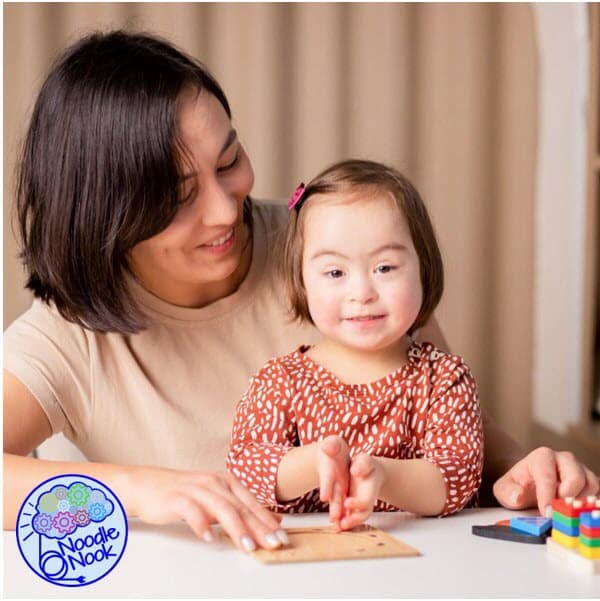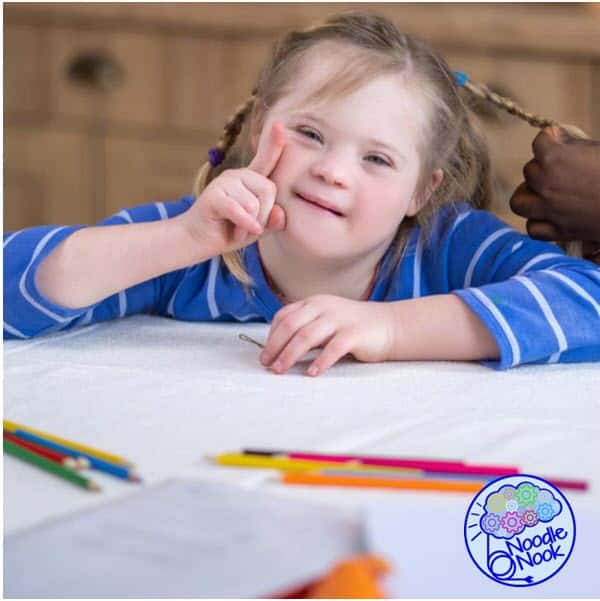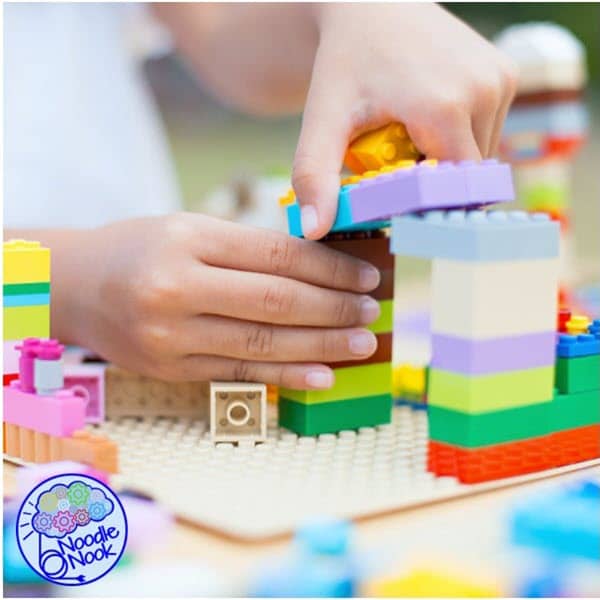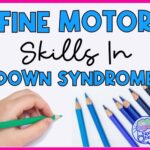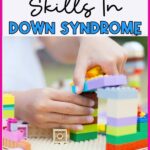As educators working with students who have significant disabilities, we know how essential it is to support their growth in various areas. Fine motor skills are the building blocks of daily activities, self-care skills, and communication, and they play a crucial role in a child’s ability to navigate the world. To do that effectively, we need some creative and effective ways to enhance fine motor skills in the classroom. Let’s dive into some ideas on developing fine motor skills in children with Down syndrome.
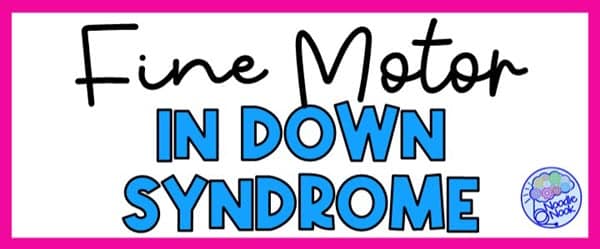
Understanding Down Syndrome and Fine Motor Skills
Before we get into the activities, let’s briefly review the characteristics of Down syndrome and its impact on fine motor skills. Down syndrome is a genetic condition caused by an extra chromosome, which affects a child’s development. Among the common physical characteristics is low muscle tone. These weaker muscles mean more challenges with gross motor skills and fine motor coordination.
Fine motor skills involve the small movements of the hands and fingers. This is as opposed to gross motor skills, which refers to abilities that involve using the large muscles of the body to perform activities, such as walking, running, jumping, balancing, and throwing. Gross motor skills involve coordination, strength, balance, and endurance. These skills are essential for overall physical development and enable individuals to engage in everyday activities and sports. Fine motor skills, on the other hand, are vital in different ways. They are essential tasks like writing, using utensils, or buttoning clothes. Children with Down syndrome may experience delays in this area, but with the right interventions and support, they can make significant progress!
Role of Occupational Therapists and Health Professionals
Occupational therapists play a pivotal role in the development of fine motor skills in children with Down syndrome. They design and implement treatment plans to address each child’s specific needs, using sensory processing techniques and motor programs. These health professionals collaborate with teachers, parents, and physical therapists to ensure a comprehensive approach to skill development.
Tips for Fine Motor Skills for Children with Down Syndrome
1. Everyday Activities:
Infuse fine motor skill practice into day-to-day activities. Have students use tongs to pick up small objects during playtime or snack breaks. This will not only strengthen their hand muscles but also enhance bilateral coordination.
2. Sensory Needs:
Create a sensory-friendly classroom environment to cater to individual’s sensory need. Provide materials with different textures, such as fabric swatches or sandpaper, to stimulate tactile exploration and refine hand skills.
3. Educational Materials:
Use educational materials like popsicle sticks, building blocks, and puzzles that require precise hand-eye coordination. These activities are both engaging and beneficial for fine motor development.
4. Fine Motor Activities:
Incorporate fun fine motor activities like threading beads, cutting with safety scissors, or using play dough. These activities offer an extra challenge while promoting creativity and cognitive skills.
5. Video Games:
Choose video games that focus on fine motor skills and hand-eye coordination. Certain games can be beneficial for skill development but always ensure appropriate screen time limits.
6. School-Based Activities:
Involve children in school-related activities that encourage fine motor skills, such as organizing supplies, turning pages in books, or using computers.
7. Family Involvement:
Encourage family members to continue fine motor skill development at home. Share ideas and activities to ensure consistent support and progress.
Activities for Fine Motor Skills in Children with Down Syndrome
We have seven ideas for activities you can do in the classroom that will help improve fine motor skills. Remember, as you draft your lessons and set up your activities that keeping them age-appropriate is important. It’s also critical that your classroom activities align with the general ed curriculum and grade level scope and sequence. With that in mind, here are seven specific activities that a teacher can implement in the classroom to improve fine motor skills:
- Playdough Creations: Provide students with playdough and encourage them to mold and shape it into various objects. This activity helps strengthen hand muscles and enhances fine motor control.
- Threading Beads: Set up a threading station with large, colorful beads and strings. Students can practice threading the beads onto the string, promoting hand-eye coordination and pincer grasp development.
- Cutting Practice: Offer safe, child-friendly scissors and paper for cutting exercises. Students can practice cutting along straight lines, zigzags, or simple shapes, which fosters hand dexterity and scissor skills.
- Puzzles and Manipulatives: Provide age-appropriate puzzles, building blocks, and other manipulatives that require students to use their fingers and hands to assemble and manipulate pieces. These activities support spatial awareness and finger control.
- Fine Motor Sensory Bins: Create sensory bins with materials like rice, beans, or sand, and hide small objects within them. Students can use their fingers to search for and retrieve the objects, strengthening their pincer grasp and sensory exploration.
- Tracing and Coloring: Offer tracing worksheets or coloring pages with bold outlines for students to practice staying within the lines. This activity encourages precision and hand-eye coordination.
- Finger Painting and Handprint Art: Engage students in finger painting or handprint art projects. These activities not only promote fine motor skills but also provide a creative outlet for self-expression.
These activities can be great in a center-based classroom or as part of a station system. Try to work with an occupational therapist if you need more specific activities that can support target students in your classroom. BONUS IDEA: Try working with Lego! Who doesn’t love the magic of Lego creations? And if you need to know how to clean classroom Lego, then check out this post here.
RECAP: Ideas on Fine Motor Skills in Children With Down Syndrome
Promoting fine motor skill development in children with Down syndrome is a collaborative effort involving teachers, occupational therapists, and family members. By understanding the unique challenges these students face, we can tailor our approach to suit their individual needs. Remember, every small step is a significant difference in the child’s growth, so celebrate each milestone achieved! Let’s continue to build a nurturing and inclusive learning environment that empowers our young learners with Down syndrome to thrive in all areas of development.
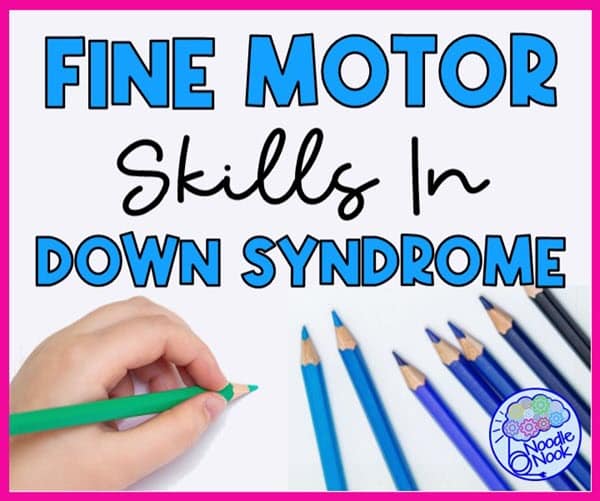
FINE MOTOR FAQ
Here are answers to some common questions about fine motor skills and teaching them to students with Down syndrome.
Q1: How can teachers address the diverse range of fine motor skill levels in a mixed-ability classroom?
A: In a mixed-ability classroom, teachers can implement inclusive strategies to accommodate the diverse range of fine motor skill levels. Differentiated instruction is key, where teachers provide varying levels of support and challenge based on individual needs. For students who need extra assistance, offering adaptive tools like pencil grips or larger writing utensils can facilitate writing tasks. At the same time, providing more complex fine motor activities, such as intricate crafts or advanced puzzles, can engage students who are ready for an extra challenge. Encouraging peer collaboration and support can also foster a positive classroom environment, where students learn from and assist each other in their fine motor skill development.
Q2: How can teachers integrate fine motor skill development into the curriculum while addressing other academic goals?
A: Integrating fine motor skill development into the curriculum is both practical and beneficial. Teachers can incorporate fine motor activities into lessons that align with academic goals. For example, during language arts, students can practice handwriting and letter formation. In math, they can use small objects like counting cubes, fostering fine motor control while learning numerical concepts. During science and art, activities like cutting and pasting support fine motor skills while exploring creativity. Teachers can also design classroom routines that include brief fine motor warm-up exercises before starting a lesson, allowing students to practice and improve hand skills in a fun and engaging way. By seamlessly weaving fine motor development into the daily curriculum, students not only enhance their hand skills but also improve their overall academic performance.
Q3: How can occupational therapy help in improving fine motor skills for students with Down syndrome?
A: Occupational therapy plays a vital role in supporting the development of fine motor skills in students with Down syndrome. Occupational therapists work closely with these young children to identify and address specific challenges related to small movements of the hand and fingers. Through tailored treatment plans and early intervention, occupational therapy focuses on building the foundational skills necessary for fine motor development.
Q4: What are the building blocks of fine motor development in children with Down syndrome?
A: The building blocks of fine motor development encompass a range of skills, including hand-eye coordination, finger dexterity, and hand strength. For children with Down syndrome, who may have medical conditions or shorter fingers, these foundational skills are especially critical. Occupational therapists and physical therapists work together to address these challenges and encourage progress in fine motor abilities.
Q5: How does fine motor development differ in students with Down syndrome compared to other intellectual disabilities, like autism spectrum disorder?
A: Each child’s development is unique, and motor skills of children with Down syndrome can vary within different age ranges. While fine motor development may be impacted by Down syndrome’s characteristic physical traits, such as low muscle tone or shorter fingers, children with this condition can still achieve remarkable progress with proper support and interventions. In contrast, children with autism spectrum disorder may have different sensory needs and social skills challenges that can also affect their fine motor development. In both cases, early intervention and therapeutic support are essential in fostering new skills and functional tasks.
Q6: How can teachers and family members support the development of fine motor skills in children with Down syndrome?
A: Teachers and family members can play great ways to encourage fine motor skill development. Consistently engaging students in activities that target fine motor skills during classroom and home environments can yield significant improvements. Incorporating activities that promote sensory experiences and social interactions can further enhance the child’s cognitive development and self-help skills.
Q7: Does the central nervous system play a role in fine motor development in young children with Down syndrome?
A: Yes, the central nervous system has a crucial role in fine motor development. It helps coordinate signals between the brain and skeletal muscles, enabling precise movements of the hands and fingers. For children with Down syndrome, who may have differences in their central nervous system, therapeutic interventions, such as occupational and physical therapy, can help optimize their fine motor abilities.
Q8: What are the typical developmental milestones for children with Down syndrome, and how do they differ from those without this condition?
A: Developmental milestones may vary for children with Down syndrome compared to typically developing children. Due to the impact of intellectual disability and sensory needs associated with Down syndrome, children may achieve certain milestones at a different pace. For instance, fine motor skills, communication skills, and intellectual development may follow a unique trajectory. Early intervention and guidance from physical therapists, occupational therapists, and other healthcare professionals are crucial. They can make or break children with Down syndrome reaching their child development milestones and future postsecondary outcomes.
Q9: How can a physical therapist assist in improving the skeletal muscle development of a child with Down syndrome?
A: Physical therapists play a vital role in enhancing skeletal muscle development in children with Down syndrome. Through specialized exercises and therapeutic interventions, physical therapists target specific muscle groups to strengthen them and improve overall mobility. They create tailored treatment plans that address the unique needs of each child and work closely with the child’s family members to ensure consistent support. By providing guidance on home exercises and activities, physical therapists empower family members to play an active role in their child’s ongoing muscle development journey.
Q10: How can a family member actively contribute to the treatment plan of a child with Down syndrome?
A: Family members play an integral role in a child’s treatment plan for Down syndrome. They are essential partners in promoting the child’s overall development and well-being. Family members can support and reinforce the therapies and activities recommended by physical therapists, occupational therapists, and other health professionals. They can engage in activities that target sensory needs, communication skills, and fine motor development in day-to-day interactions with the child. By creating a nurturing and supportive environment at home, family members significantly contribute to the child’s progress and overall quality of life. Regular communication with the child’s healthcare team ensures that the treatment plan remains cohesive and focused on achieving the child’s individual goals.
Learning More
Remember, you can find more in-depth information and resources on this topic in publications like “Woodbine House,” which offer valuable insights into effective strategies for supporting children with Down syndrome. You can also check out the training session I have on teaching students with Down syndrome HERE.

